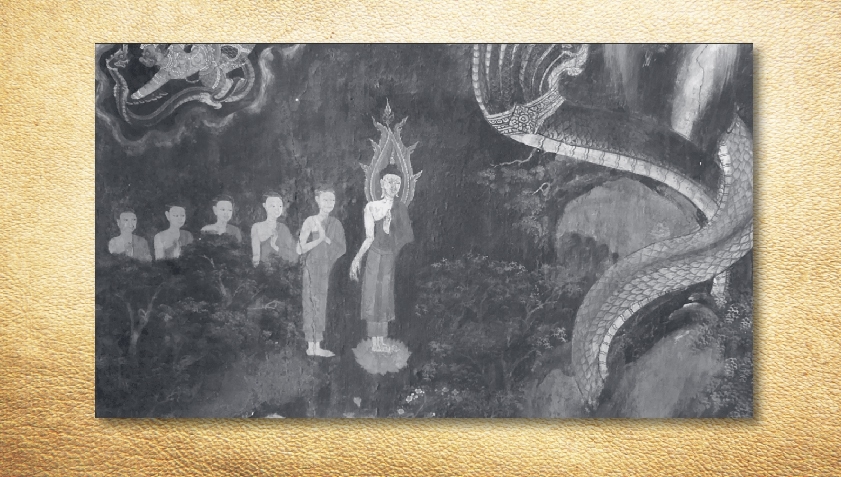Nanthopananthasutra Khamluang: Extraordinariness, Meanings and Beliefs of the 'Great Naga' Names
Keywords:
Nanthopananthasutra Khamluang, Synonym, Meaning, Belief and ConceptAbstract
This study investigated the varieties of terms referred to ‘Phaya Nanthopananthanakaracha’. Forty-eight references have been found in this study reflecting the intellectual competence of Prince Dharmathibes Chaiyachet Suriyawong (Chaofah Kung), the author of “Nanthopananthasutra Khamluang.” Furthermore, the results revealed the author had the intellectual capability to produce the names of ‘Phaya Nanthopanantha Nakaracha’ using 3 methods. The first method was the synonyms of ‘Phaya Nanthopanantha Nakaracha’, 7 keywords were found, “Naga” (the great animal) was commonly used, “Pharanaracha” (the great of a serpent), “Uraka” (the animal that moves with chest), “Asiwisa” (the animal with venomous head), “Salapa” (the serpent), “Thawichiwha” (the animal with forked tongue), “Phuchangka” (the coiled animal). The second method was the compounding technique of the great Naga names. Five compounding techniques were found: beginning with “Phraya” and ending with the name of great Naga, beginning with the word “Phraya” and ending with the word “Racha.”, beginning with specific names and ending with the word “Naga.”, beginning with specific names and ending with the word “Racha.”, beginning with specific names and ending with the word “Badan.” The third method was the meaning of ‘Phaya Nanthopanantha Nakaracha’ which reflected beliefs and concepts about the great Naga in the Ayutthaya period. Four types of meanings were found: the greatness, the animal with forked tongue, the beast, and the ownership of netherworld (the world of water).
References
กรมศิลปากร, 2513. เจ้าฟ้าธรรมาธิเบศ พระประวัติและพระนิพนธ์ร้อยกรอง. กรุงเทพฯ: โรงพิมพ์รุ่งวัฒนา.
เจ้าฟ้าธรรมาธิเบศร์ไชยเชษฐ์สุริยวงศ์, 2279. นันโทปนันทสูตรคำหลวง (หนังสือสมุดไทย). กรุงเทพฯ: สํานักหอสมุดแห่งชาติ.
ดนัย พลอยพลาย และ ศิริพร ภักดีผาสุข, 2560. “พระนามเจ้าฟ้าสมัยรัตนโกสินทร์: การศึกษาความสัมพันธ์ระหว่างภาษากับวัฒนธรรมไทย.” วารสารอักษรศาสตร์. 46 (1): 59-97.
นิตยา กาญจนะวรรณ, 2539. วรรณกรรมอยุธยา. กรุงเทพฯ: สํานักพิมพ์มหาวิทยาลัยรามคําแหง.
ป.หลงสมบุญ, พันตรี, 2546. พจนานุกรมมคธ-ไทย. พิมพ์ครั้งที่ 2. กรุงเทพฯ: เรืองปัญญา.
ประเสริฐ ณ นคร, 2541. สารนิพนธ์ประเสริฐ ณ นคร. กรุงเทพฯ: มหาวิทยาลัยเกษตรศาสตร์.
ปานทิพย์ มหาไตรภพ, 2545. นามสกุลพระราชทานในพระบาทสมเด็จพระมงกุฎเกล้าเจ้าอยู่หัว: การวิเคราะห์เชิงอรรถศาสตร์ชาติพันธุ์. วิทยานิพนธ์ศิลปศาสตรมหาบัณฑิต สาขาวิชาภาษาศาสตร์ คณะอักษรศาสตร์ จุฬาลงกรณ์มหาวิทยาลัย, กรุงเทพฯ.
พระมหาสมปอง มุทิโต, 2547. คัมภีร์อภิธานวรรณนา. พิมพ์ครั้งที่ 2. กรุงเทพฯ: บริษัท ประยูรวงศ์พริ้นติ้ง จํากัด.
พระโสภณวิหารการ, 2554. ศึกษาวิเคราะห์แนวคิดเรื่องพญานาคในคัมภีร์พระพุทธศาสนาเถรวาท. วิทยานิพนธ์พุทธศาสตรดุษฎีบัณฑิต สาขาวิชาพระพุทธศาสนา มหาวิทยาลัยมหาจุฬาลงกรณราชวิทยาลัย, พระนครศรีอยุธยา.
พระอุดรคณาธิการ (ชวินทร์ สระคํา) และ จําลอง สารพัดนึก, 2530. พจนานุกรมบาลี-ไทย ฉบับนักศึกษา. พิมพ์ครั้งที่ 2. กรุงเทพฯ: เรืองปัญญา.
วิเชียร นามการ, จ่าสิบเอก, 2554. การศึกษาอิทธิพลความเชื่อเรื่องพญานาคที่มีผลต่อสังคมไทยปัจจุบัน. วิทยานิพนธ์พุทธศาสตรมหาบัณฑิต สาขาวิชาพระพุทธศาสนา บัณฑิตวิทยาลัยมหาวิทยาลัยมหาจุฬาลงกรณราชวิทยาลัย, พระนครศรีอยุธยา.
สุภาพรรณ ณ บางช้าง, 2527. การใช้ภาษาในการตั้งชื่อของคนไทย. กรุงเทพฯ: จุฬาลงกรณ์มหาวิทยาลัย.
หลวงเทพดรุณานุศิษฏ์ (ทวี ธรมธัช ป.9), 2540. ธาตุปฺปทีปิกา หรือ พจนานุกรมบาลี-ไทย. พิมพ์ครั้งที่ 7. กรุงเทพฯ: โรงพิมพ์มหามกุฏราชวิทยาลัย.

Downloads
Published
Issue
Section
License
บทความนี้เป็นผลงานของข้าพเจ้าแต่เพียงผู้เดียว และ/หรือเป็นผลงานของข้าพเจ้าและผู้ร่วมงาน ตามชื่อที่ระบุในบทความจริง และเป็นผลงานที่มิได้ถูกนำเสนอหรือตีพิมพ์ที่ใดมาก่อน




